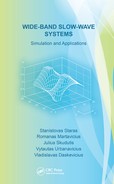Book Description
The field of electromagnetics has seen considerable advances in recent years, based on the wide applications of numerical methods for investigating electromagnetic fields, microwaves, and other devices. Wide-Band Slow-Wave Systems: Simulation and Applications presents new technical solutions and research results for the analysis, synthesis, and design of slow-wave structures for modern electronic devices with super-wide pass-bands. It makes available, for the first time in English, significant research from the past 20 years that was previously published only in Russian and Lithuanian.
The authors examine electrodynamics, multiconductor lines, and numerical methods for the modeling, simulation, analysis, and design of various super-wide-band slow-wave structures, including helical, meander, and gutter-type systems.
The book features:
- The electrodynamic method for analysis of helical structures containing periodical inhomogeneities
- The multiconductor line method for analysis of complex helical, meander, and gutter-type wide-band slow-wave structures
- The method of moments for modeling and analysis of multiconductor lines containing a limited number of lines and meander structures with limited length
- Use of powerful software systems Microwave Office®, MICROWAVE STUDIO®, and MATLAB® for modeling, analysis, and design
- A synergy of various methods for investigating and designing wide-band slow-wave structures
- Solution of specific problems related to the design of wide-band and super-wide-band electrodynamic delay and deflection systems
- Principles of computer-aided design of slow-wave structures
Presenting the theory, principles, properties, and applications of wide-band and super-wide-band slow-wave structures, this book will be of interest to students, engineers, researchers, and designers in the fields of electronic and microwave engineering.
Table of Contents
- Cover
- Half Title
- Title Page
- Copyright Page
- Table of Contents
- Introduction
- Symbols and Acronyms
- 1 Analysis of Nonhomogeneous Helical Systems Using Electrodynamical Methods
- 2 Multiconductor Line Method
- 2.1 Electromagnetic Waves in Multiconductor Lines
- 2.2 Voltages and Currents in Multiconductor Lines
- 2.3 Normal Waves in Multiconductor Lines
- 2.4 Dependence of Wave Admittances and Effective Dielectric Permittivities on Phase Angle
- 2.5 Calculation of Capacitances
- 2.6 Principles of Modeling of Slow-Wave Structures
- 2.7 Application of the Multiconductor Line Method for Analysis of Nonhomogeneous Systems
- 2.8 Calculations of Frequency Characteristics Using Numerical Iterations
- 2.9 Application of Scattering Transmission Line Matrices
- 2.10 Summary
- References
- 3 Calculation of Characteristic Impedances of Multiconductor Lines
- 3.1 Finite Difference Method
- 3.2 Finite Element Method
- 3.3 Integral Equation Method
- 3.4 Application of the Method of Integral Equations
- 3.5 Summary
- References
- 4 Models and Properties of Slow-Wave Systems
- 4.1 Models and Properties of Special Types of Helical Systems
- 4.2 Gutter-Type Helical and Meander Systems
- 4.3 Influence of Periodical Inhomogeneities on Properties of Slow-Wave Systems
- 4.4 Simulation of Meander Systems with Finite Length
- 4.5 Summary
- References
- 5 Investigation of Slow-Wave Systems Applying Versatile Electromagnetic Simulation and Design Tools
- 5.1 Model of a Helical Slow-Wave System
- 5.2 Investigation of the Twined Helical Slow-Wave System
- 5.3 Input Impedance of Helical Systems
- 5.4 Resonances in the System of Shields and Possibilities of Avoiding Them
- 5.5 Application of Software for Three-Dimensional Modeling
- 5.6 Summary
- References
- 6 Investigation of Slow-Wave Structures Using Synergy of Various Methods
- 7 Application of Slow-Wave Structures for Deflection of Electron Beams
- 7.1 Correction of Phase Distortions in Traveling-Wave Deflecting Systems
- 7.2 Electrical Field in the Deflecting System
- 7.3 Nonlinear Distortions in Traveling-Wave Cathode-Ray Tubes
- 7.4 Simulation of Transitions to Traveling-Wave Deflecting Systems
- 7.5 Opportunities for Improvement of Dynamic Characteristics of Traveling-Wave Cathode-Ray Tubes and Their Signal Paths
- 7.6 Conclusions
- References
- 8 Application of Slow-Wave Systems for Delay
- 8.1 Simulation of Meander Systems Containing Periodical Inhomogeneities
- 8.2 Properties of Packaged Microstrip Meander Systems
- 8.2.1 Dispersion Properties of Packaged Microstrip Meander Delay Lines
- 8.2.2 Dispersion Properties of Packaged Microstrip Meander Delay Lines Containing Periodical Inhomogeneities
- 8.2.3 Input Impedance of Packaged Microstrip Meander Delay Lines
- 8.2.4 Input Impedance of Packaged Microstrip Meander Delay Lines Containing Periodical Inhomogeneities
- 8.3 Characteristic Impedance of Meander Systems
- 8.4 Models of Meander Systems Containing Additional Shields
- 8.5 Analysis of Wide-Band Meander Slow-Wave Systems Using an Advanced Model
- 8.6 Wide-Band Modified Gutter-Type Delay Lines
- 8.7 Summary
- References
- 9 Computer-Aided Design of Electrodynamical Delay Lines
- 9.1 General Information
- 9.2 Methodology of Computer-Aided Design of Wide-Band Meander Systems
- 9.3 Principles of Synthesis of Initial Structure of Microstrip Meander Delay Line Containing Additional Shields
- 9.4 Algorithm for Synthesis of Microstrip Meander Delay Lines
- 9.5 Methodology and Algorithm for Design of Helical Delay Lines
- 9.6 Summary
- References
- Index
